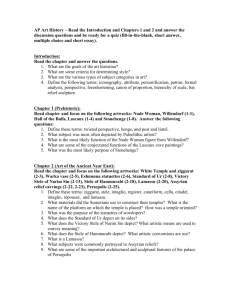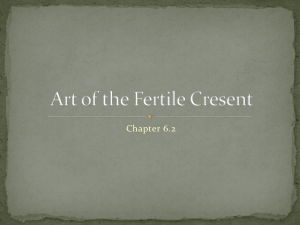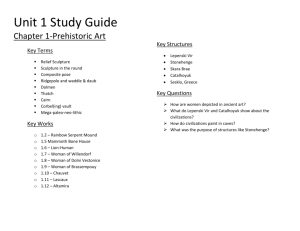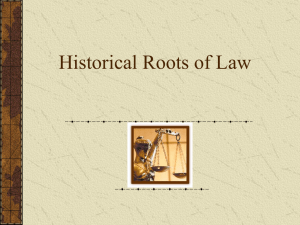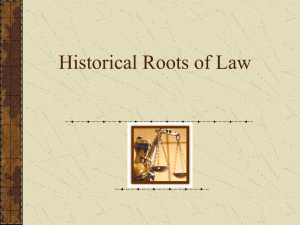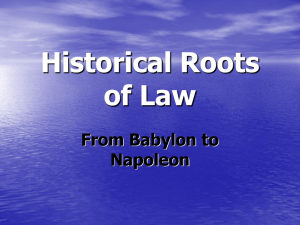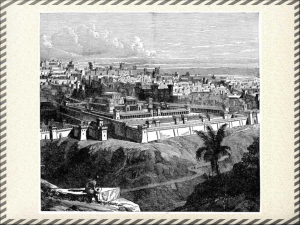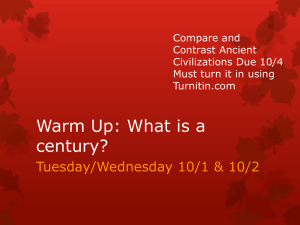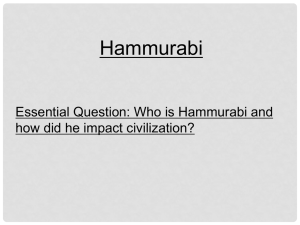Art of the Ancient Near East images 2013
advertisement
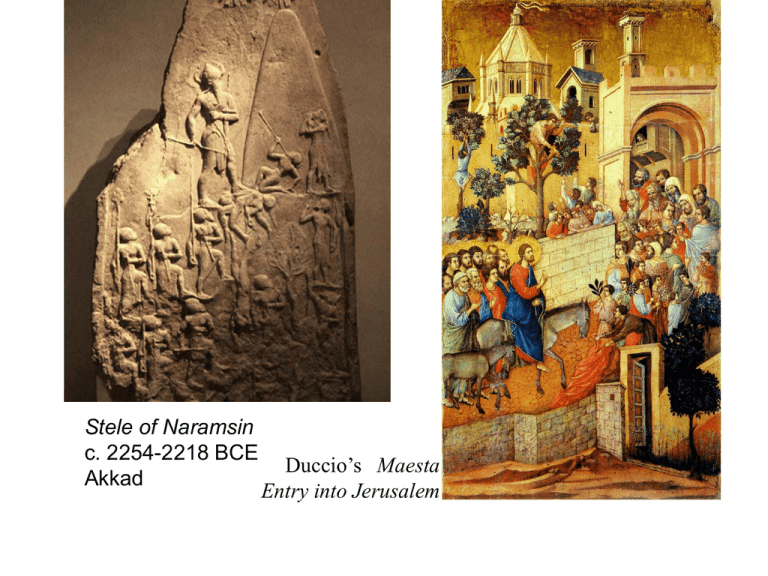
Stele of Naramsin c. 2254-2218 BCE Akkad Duccio’s Maesta Entry into Jerusalem Art of the Ancient Near East Votive Statue of Gudea c. 2120 BCE What does the word “votive” mean? Why do the votive figures have proportionally enormous eyes? Votive Statues c. 2900-2600 The Ziggurat of Ur c. 2100-2050 BCE in Modern Iraq What is a ziggurat? What is the symbolic function of a ziggurat? What is the political purpose of a ziggurat? The Ziggurat of Ur c. 2100-2050 BCE in Modern Iraq A ziggurat is meant to act as a bridge heaven and earth. A ziggurrat is also meant to proclaim the wealth and prestige of a city as well as the strength and stability of a city’s rules or laws (remember Antigone and what Creon claimed: the city is our safety). Practically, a ziggurat is a stepped pyramid structure with a temple or shrine on top. How is this Mayan Temple (5th7th century CE; Palenque, Mexico) similar to a ziggurat? Hint: Think about the symbolic function of each. Stele of Naramsin c. 2254-2218 BCE Akkad This stele is meant to commemorate an important victory. Things to think about: Why is Naramsin so much bigger than the other figures in the relief? Do you remember the term “hieratic scale”? Where do all the soldiers—both the vanquished mountain people as well as Naramsin’s soldiers—gaze? What do the three suns at the top of the stele symbolize? What does Narasim’s horned helmet symbolize? What is the wavy line meant to indicate? Can you tell the difference between Naramsin’s soldiers and the vanquished? Can you find the vanquished soldier who is fleeing? Can you find the vanquished soldier that Narasim crushes with his foot? Stele of Naramsin c. 2254-2218 BCE Akkad Stele of Naramsin c. 2254-2218 BCE Akkad Who are the two men at the top of the stele? What is the significance of this stele? What was the king’s role? What is the significance of the lower two-thirds of this stele? Stele of Hammurabi c. 1792-1750 Babylonia Stele of Hammurabi c. 1792-1750 The two men at the top of the stele are Hammurabi and Shamash (the sun god and god of justice). Hammurabi created the most important set of legal codes from the Ancient Near East. These legal codes predate the biblical Ten Commandments and may be the source of these laws. This image on the stele argues powerfully that Hammurabi’s code was given directly to him by god—by Shamash. Notice the rays of light which emanate from Shamash’s shoulders. He is seated on a throne which is “seated” at the top of a mountain. Notice too that Hammurabi is almost as large as Shamash; Hammurabi addresses Shamash directly. The idea represented here is that the laws are somehow immutable and divine--the laws are given to man by god. Stele of Hammurabi c. 1792-1750 This stele is intended to ensure the uniform treatment of people throughout the kingdom. Below the image of Shamash and Hammurabi there is a tremendous amount of writing in cuneiform. This text has three parts: the first enacts the king’s investiture—his right to rule; the second section of the text is an ode to the king’s glory (Hammurabi is the best and most powerful of all kings); the third part is the most significant to us. The third section records three hundred specific laws that govern Babylonia. These laws were written in cuneiform in an accessible language and were meant to be easily understood by the common man. The language is very direct; forbidden actions and the requisite punishment are recorded. Significantly, the laws are uniform and apply to all people regardless of wealth, class, or gender. The king’s role is to act as an intermediary between his citizens and the gods. Human-Headed Winged Lion Lamassu (plural: lamassus) 883-859 Assyrian This sculpture has the bearded head of a man, the powerful body of a lion or bull, the wings of an eagle, and the horned headdress of a god. A pair of these sculptures would flank the entry to the throne room. What is a lamassu? Why is a lamassu large—usually twice a man’s height? What is the purpose of the lamassu? Human-Headed Winged Lion Lamassu (plural: lamassus) 883-859 Assyrian The entire purpose of a lamassu is to inspire civic pride and to inspire fear. A lamassu is a guardianprotector of an Assyrian palace or throne room. Usually a lamassu is twice a man’s height to symbolize the strength of the ruler the lamassu defends. Why does the lamassu have five legs? Hint: How is the viewer meant to interact with this sculpture? Human-Headed Winged Lion Lamassu How have the sculptors deliberately indicated that the king, which the viewer is about to see, is god-like? Hint: Notice the “crown which the lamassu wears: how many “horns” or folds does it have? Assurnasirpal II Killing Lions c. 850 BCE Why would an image of the king killing lions help create power? Or rather the cult of power? Are there any other images of “power” that you can connect to this one? This relief is at the British Museum in London; the Met in New York City has quite a few as well. Ishtar Gate and Throne Room Wall Neo-Babylonia c. 575 BCE There were eight double gates that surrounded the city of Babylon. N, ascended to the throne and proceeded to rebuild the ancient city of Babylon. This gate and the wall are the remnants of N. building program. He fortified and strengthened eleven miles of wall around the city; he reconstructed the Great Ziggurat of Babylon, he created palaces and hanging gardens. The lions represent Ishtar. The Flood Tablet, relating part of the Epic of Gilgamesh Gold Coin of Croesus Daric coin, first minted under Darius I of Persia, 4th century BCE
